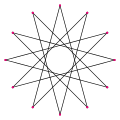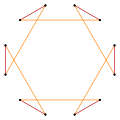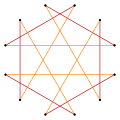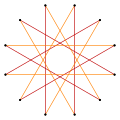Dodecagon
| Regular dodecagon | |
|---|---|
 A regular dodecagon | |
| Type | Regular polygon |
| Edges and vertices | 12 |
| Schläfli symbol | {12}, t{6}, tt{3} |
| Coxeter–Dynkin diagrams | |
| Symmetry group | Dihedral (D12), order 2×12 |
| Internal angle (degrees) | 150° |
| Properties | Convex, cyclic, equilateral, isogonal, isotoxal |
| Dual polygon | Self |
In geometry, a dodecagon is any twelve-sided polygon or 12-gon.
Regular dodecagon
A regular dodecagon has Schläfli symbol {12} and can be constructed as a truncated hexagon, t{6}, or a twice-truncated triangle, tt{3}.
It has all sides of equal length and all angles equal to 150°. It has 12 lines of symmetry and rotational symmetry of order 12. Its Schläfli symbol is {12}.
The area of a regular dodecagon with side a is given by:
Or, if R is the radius of the circumscribed circle,[1]
And, if r is the radius of the inscribed circle,
A simple formula for area (given the two measurements) is: where d is the distance between parallel sides.
Length d is the height of the dodecagon when it sits on a side as base, and the diameter of the inscribed circle.
By simple trigonometry, .
The perimeter for an inscribed dodecagon of radius 1 is 12√(2 - √3), or approximately 6.21165708246. [2]
The perimeter for a circumscribed dodecagon of radius 1 is 24(2 – √3), or approximately 6.43078061835. Interestingly, this is double the value of the area of the inscribed dodecagon of radius 1. [3]
With respect to the above-listed equations for area and perimeter, when the radius of the inscribed dodecagon is 1, note that the area of the inscribed dodecagon is 12(2 – √3) and the perimeter of this same inscribed dodecagon is 12√(2 - √3).
Dodecagon construction
As 12 = 22 × 3, regular dodecagon is constructible using compass and straightedge:

Construction of a regular dodecagon
Dissection
Coxeter states that every parallel-sided 2m-gon can be divided into m(m-1)/2 rhombs. For the dodecagon, m=6, and it can be divided into 15 rhombs, with one example shown below. This decomposition is based on a Petrie polygon projection of a 6-cube, with 15 of 240 faces.[4]
 With hexagons, squares, and triangles |
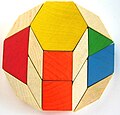 pattern blocks |
 With 15 rhombs from 6-cube |
 With 15 rhombs |
One of the ways the mathematical manipulative pattern blocks are used is in creating a number of different dodecagons.[5]
Symmetry

The regular dodecagon has Dih12 symmetry, order 24. There are 15 distinct subgroup dihedral and cyclic symmetries. Each subgroup symmetry allows one or more degrees of freedom for irregular forms. Only the g12 subgroup has no degrees of freedom but can seen as directed edges.
 r24 | ||||||
|---|---|---|---|---|---|---|
 d12 |
 g12 |
 p12 |
 i8 | |||
 d6 |
 g6 |
 p6 |
 d4 |
 g4 |
 p4 | |
 g3 |
 d2 |
 g2 |
 p2 | |||
 a1 | ||||||
Occurrence
Tiling
A regular dodecagon can fill a plane vertex with other regular polygons in 4 ways:

|

|
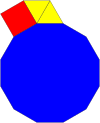
|

|
| 3.12.12 | 4.6.12 | 3.3.4.12 | 3.4.3.12 |
|---|
Here are 3 example periodic plane tilings that use regular dodecagons, defined by their vertex configuration:
| 1-uniform | 2-uniform | |
|---|---|---|
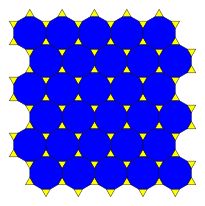 3.12.12 |
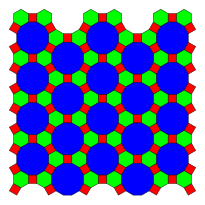 4.6.12 |
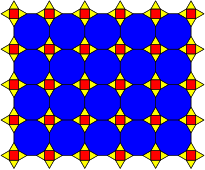 3.12.12; 3.4.3.12 |
Skew dodecagon

A skew dodecagon is a skew polygon with 12 vertices and edges but not existing on the same plane. The interior of such an dodecagon is not generally defined. A skew zig-zag dodecagon has vertices alternating between two parallel planes.
A regular skew dodecagon is vertex-transitive with equal edge lengths. In 3-dimensions it will be a zig-zag skew dodecagon and can be seen in the vertices and side edges of a hexagonal antiprism with the same D5d, [2+,10] symmetry, order 20. The dodecagrammic antiprism, s{2,24/5} and dodecagrammic crossed-antiprism, s{2,24/7} also have regular skew dodecagons.
Petrie polygons
The regular dodecagon is the Petrie polygon for many higher-dimensional polytopes, seen as orthogonal projections in Coxeter planes. Examples in 4 dimensionare the 24-cell, snub 24-cell, 6-6 duoprism, 6-6 duopyramid. In 6 dimensions 6-cube, 6-orthoplex, 221, 122. It is also the Petrie polygon for the grand 120-cell and great stellated 120-cell.
|
Regular skew dodecagons in higher dimensions
| ||||||||||||||||||||||
Related figures
A dodecagram is a 12-sided star polygon, represented by symbol {12/n}. There is one regular star polygon: {12/5}, using the same vertices, but connecting every fifth point. There are also three compounds: {12/2} is reduced to 2{6} as two hexagons, and {12/3} is reduced to 3{4} as three squares, {12/4} is reduced to 4{3} as four triangles, and {12/6} is reduced to 6{2} as six degenerate digons.
Deeper truncations of the regular dodecagon and dodecagrams can produce isogonal (vertex-transitive) intermediate star polygon forms with equal spaced vertices and two edge lengths. A truncated hexagon is a dodecagon, t{6}={12}. A quasitruncated hexagon, inverted as {6/5}, is a dodecagram: t{6/5}={12/5}.[7]
Examples in use
In block capitals, the letters E, H and X (and I in a slab serif font) have dodecagonal outlines. A cross is a dodecagon.

The regular dodecagon features prominently in many buildings. The Torre del Oro is a dodecagonal military watchtower in Seville, southern Spain, built by the Almohad dynasty. The early thirteenth century Vera Cruz church in Segovia, Spain is dodecagonal. Another example is the Porta di Venere (Venus' Gate), in Spello, Italy, built in the 1st century BC has two dodecagonal towers, called "Propertius' Towers".
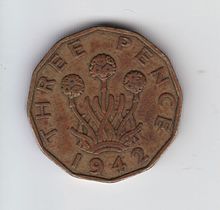
Regular dodecagonal coins include:
- British threepenny bit from 1937 to 1971, when it ceased to be legal tender.
- British One Pound Coin to be introduced in 2017.
- Australian 50-cent coin
- Fijian 50 cents
- Tongan 50-seniti, since 1974
- Solomon Islands 50 cents
- Croatian 25 kuna
- Romanian 5000 lei, 2001–2005
- Canadian penny, 1982–1996
- South Vietnamese 25 đồng, 1968–1975
- Zambian 50 ngwee, 1969–1992
- Malawian 50 tambala, 1986–1995
- Mexican 20 centavos, 1992-2009
See also
- Dodecagonal number
- Dodecahedron – a regular polyhedron with 12 pentagonal faces.
- Dodecagram
Notes
- ^ See also Kürschák's geometric proof on the Wolfram Demonstration Project
- ^ Plane Geometry: Experiment, Classification, Discovery, Application by Clarence Addison Willis B., (1922) Blakiston's Son & Company, p. 249 [1]
- ^ Elements of geometry by John Playfair, William Wallace, John Davidsons, (1814) Bell & Bradfute, p. 243 [2]
- ^ Coxeter, Mathematical recreations and Essays, Thirteenth edition, p.141
- ^ "Doin' Da' Dodeca'" on mathforum.org
- ^ John H. Conway, Heidi Burgiel, Chaim Goodman-Strauss, (2008) The Symmetries of Things, ISBN 978-1-56881-220-5 (Chapter 20, Generalized Schaefli symbols, Types of symmetry of a polygon pp. 275-278)
- ^ The Lighter Side of Mathematics: Proceedings of the Eugène Strens Memorial Conference on Recreational Mathematics and its History, (1994), Metamorphoses of polygons, Branko Grünbaum
External links
- Weisstein, Eric W. "Dodecagon". MathWorld.
- Kürschak's Tile and Theorem
- Definition and properties of a dodecagon With interactive animation





















